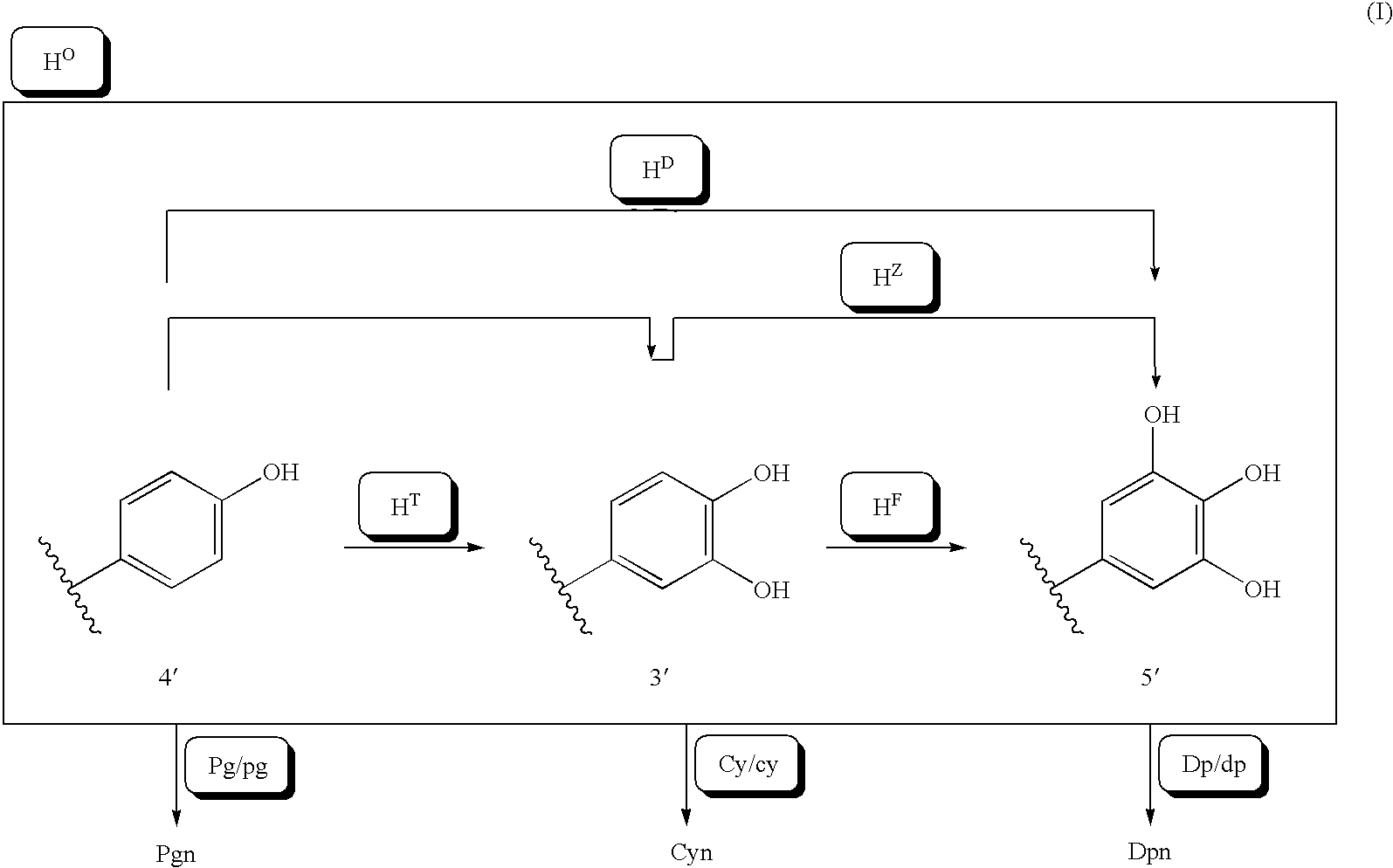Method of crossing flower color genotypes
a flower color and genotype technology, applied in the field of flower color genotype crossing, can solve the problems of large number of practical applications, inability to apply, and not yet put into practice, and achieve the separation ratio of progeny terms
- Summary
- Abstract
- Description
- Claims
- Application Information
AI Technical Summary
Benefits of technology
Problems solved by technology
Method used
Image
Examples
example 1
[0053] Flower petals, peels, and leaves were collected, and as for flower petals and calyx and the like, colored portions of full color type or edge colored (including double flower) portions having the same color, and white portions were cut out, and they were correctly weighted. Thereafter, an acidic solvent, such as 0.5 to 2 N hydrochloric acid (0.5-2 N HCl) was added, and then anthocyanins were extracted. The extraction was performed according to literature (Uddin, et al.: J. Jpn. Soc. Hort. Sci., 71:40-47, 2002; Wang, et al.: J. Plant Res., 114:213-221, 2001; Naotaka Matsuzoe and 5 others: Engakuzatsu, 68:138-145, 1999). The extract was subjected to cotton filtration, and thereafter the filtrate was heated at 100 degree C. to carry out hydrolysis to obtain one to six types of anthocyanidin. The hydrolysis was performed according to literature (Uddin, et al.: J. Jpn. Soc. Hort. Sci., 71: 40-47, 2002). After the reaction was completed, the reaction mixture was filtrated through a...
example 3
[0058] S1-generations of lisianthus shown in Table 1 were used as parent stain, and they were subjected to self-pollination, and separated to obtain S2-generations, which were examined to determine pigment genotypes of various lines. The results are shown in Table 3.
TABLE 3X2 DetectedPigmentObservedExp. ValueValueAdaptedPhenotypeValuePigment Genotype(Sep. Ratio)*P ValueSeparation of progenies by Self-pollination of G2D3B27E(ddeeHTHFpgpgCyCyDpDp pigment genotype) Line (F2)CynDpn22ddeeHTHFpgpg CyCyDpDp21.811*0.404Cyn9ddeeHTHTpgpg CyCyDpDp1None6ddeeHFHFpgpg CyCyDpDp1Separation of progenies by Self-pollination of G2D3B29A(ddeeHFHFPgpgCyCyDpDp pigment genotype) Line (F2 and F3)Pgn24ddeeHFHFPg- CyCyDpDp30.771*0.380None11ddeeHFHFpgpg CyCyDpDp1Separation of progenies by Self-pollination of G2D3B25F(ddeeHFHFPgPgCyCyDpDp pigment genotype) Line (F2 and F3)Pgn76ddeeHFHFPgPg CyCyDpDp1—1.000Separation of progenies by Self-pollination of G2D3B27Y(ddeeHTHTpgpgCyCyDpDp pigment genotype) Line (F2)C...
example 4
[0060] When red white flower having Pgn-phenotype (G2D3B25F line, ddeeHFHFPgPgCyCyDpDp pigment genotype) and red flower having Cyn-phenotype (G2D3B27Y line, ddeeHTHTpgpgCyCyDpDp pigment genotype) were subjected to cross-pollination, red purple flower having PgnCynDpn-phenotype (ddeeHTHFpgpgCyCyDpDp pigment genotype) was obtained. Non-Patent Document 6 (Kana Kobayashi, Ilusyu Gakkai-Zasshi, 48:169-176, 1998) which assumes pigment phenotype), discloses that flower having PgnCyn-phenotype is obtained, and the separation of red purple flower having PgnCynDpn-phenotype cannot be explained.
PUM
| Property | Measurement | Unit |
|---|---|---|
| Color | aaaaa | aaaaa |
Abstract
Description
Claims
Application Information
 Login to View More
Login to View More - R&D
- Intellectual Property
- Life Sciences
- Materials
- Tech Scout
- Unparalleled Data Quality
- Higher Quality Content
- 60% Fewer Hallucinations
Browse by: Latest US Patents, China's latest patents, Technical Efficacy Thesaurus, Application Domain, Technology Topic, Popular Technical Reports.
© 2025 PatSnap. All rights reserved.Legal|Privacy policy|Modern Slavery Act Transparency Statement|Sitemap|About US| Contact US: help@patsnap.com



